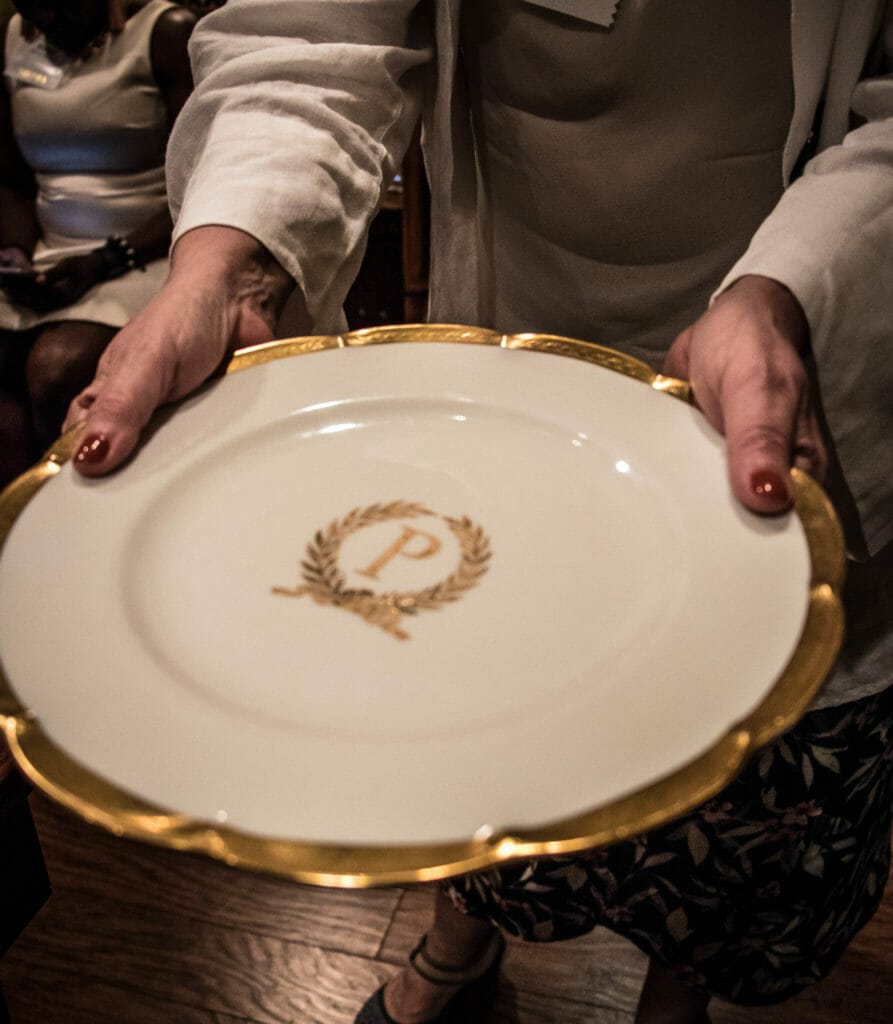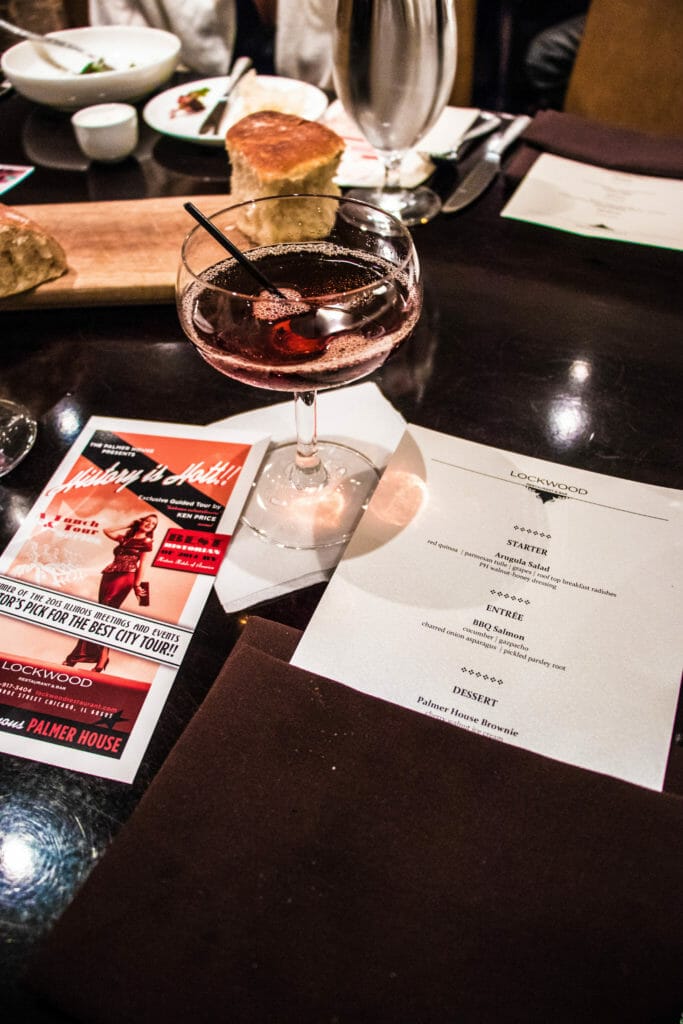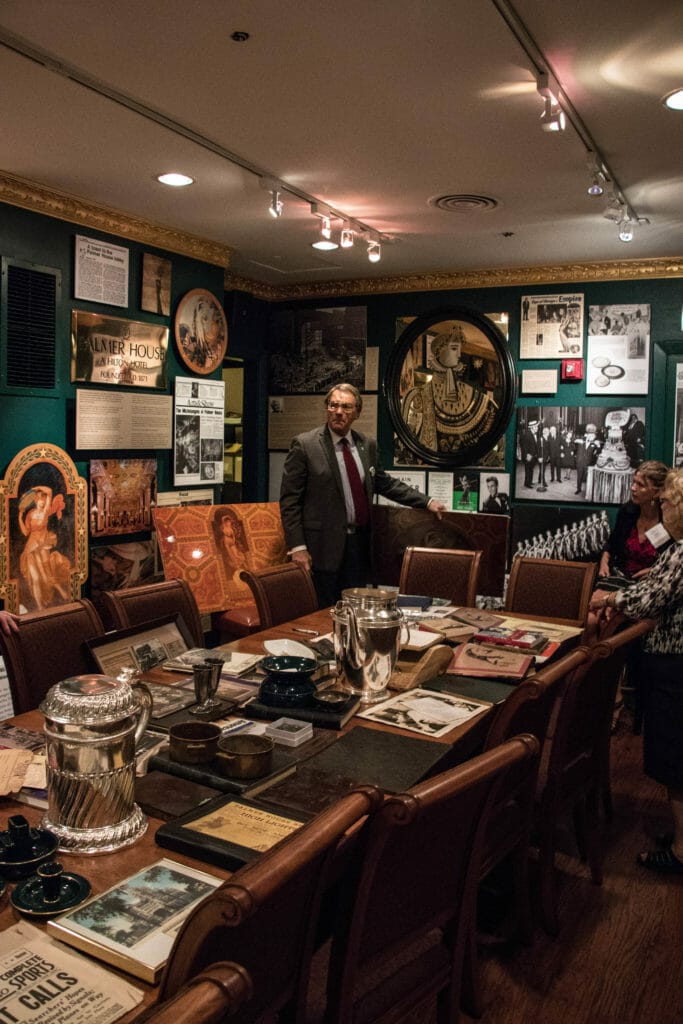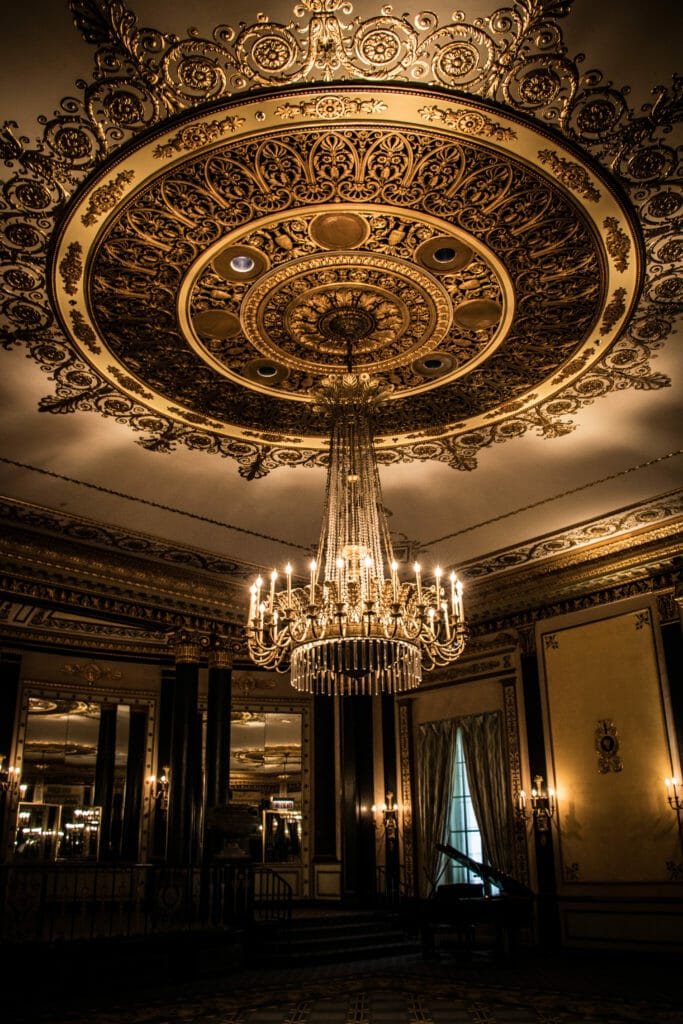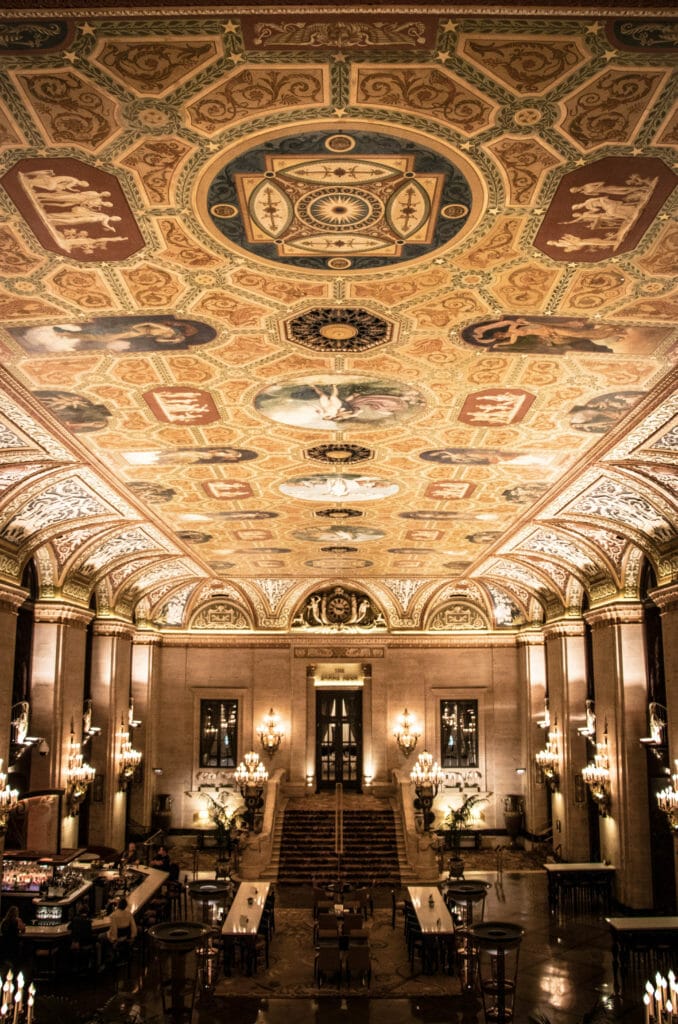Picture This…
You are sitting in a room surrounded by a large collection of memorabilia of Bertha Honoré Palmer while passing around a rare plate … made with gold. Mention is made of all the 000s in its cost. “Make sure you hold it with both hands please—don’t want that to fall!”
The Palmer House Hilton is a historic hotel that was built as a wedding present from Potter Palmer to his wife Bertha Honoré. Actually, that hotel burned down thirteen days later in the Great Chicago Fire. They later rebuilt the Palmer House two more times before we got the hotel that we know today. After the fire, Potter Palmer was understandably very concerned about fire hazards, and this new hotel is claimed to be the first and only fully fireproof hotel in the United States at the time.
The tour can include a prixe-fixe menu at the Lockwood Restaurant or the standalone History is Hott! Tour with Ken Price, winner of the 2014 Best Historian award by Historic Hotels of America.
As we sat down for lunch, we were offered Manhattan cocktails, made from maple syrup said to be stored in vaults that are even below the CTA tunnels. We then sat down to have an appetizer of arugula salad with pickled grape and champagne-honey dressing, tasting the bitterness of arugula complementing the sweetness of the grapes.
Ken Price stood up and explained the tour and why the tour is important to the preservation of historic hotels such as the Palmer House. Historic Hotels of America works to maintain these historic hotels to preserve their authenticity and architectural integrity. Many historic hotels such as the Palmer House have put extra effort and money to help their cities thrive architecturally, by preserving these significant parts of their history.
Membership into the prestigious Historic Hotels of America Program involves being nominated and selected. The hotel must be at least 50 years old and be designated by the U.S Secretary of the Interior as a National Historic Landmark. There are now over 295 historic hotels that have achieved this status.
After the appetizer, we were served our entrée of BBQ salmon with asparagus salad., They were quick to accommodate this vegetarian writer with a mushroom pasta. The pasta was very tasty, with a black truffle topping that created a rich, earthy, and delicious flavor.
Then, came the luncheon's main attraction—The Palmer House’s world famous brownie. You learn that the first reference to the word “brownie” was made in the Palmer House Kitchen. The recipe, over a century old, is still the same one they use today.
After the meal was over your tour begins in a small museum covered floor to ceiling with memorabilia of the Palmer House and the dynamic Bertha Honoré—suffragette, trend-setting art collector, and business woman. On the walls are framed vintage documents and photographs of famous figures from over the course of the Palmer House’s 145-year history move your eyes up and down as you take in the history lesson being presented. Price began by describing the impact that Bertha had on not only the Palmer House but also all of Chicago and the women's movement. As a member of the Chicago Woman’s Club, Bertha prided herself on working for the rights of working women and discussing social problems. She was heavily involved in the movement for women’s voting rights.
The architecture in the Palmer House is ornate throughout, stunning to the eye the moment one steps into any room. Every room has a unique theme or is defined by statement pieces. Some rooms, such as the Empire Room, are decorated with intricate chandeliers plated with real gold and copper. The chandeliers hung from intricate designs made of copper and gold, spilling into the rest of the ceiling creating two attention-getting focal points above. The elaborate circular pattern made you want to stand at the center of the chandelier and just look up. This room was originally used for extravagant balls. Today, the Empire Room is used as a room for conferences, corporate events, and weddings.
One of the main attractions of the building is the ceiling in the main lobby. This ceiling is designed with intricate depictions of prominent figures in Greek mythology, created by muralist Louis Pierre Rigal. Some figures include: Aphrodite the goddess of love; Apollo the god of music; and Pluto the god of the underworld. Throughout the lobby, there are “Winged Angels” prominently posted, each made of bronze and layers of twenty-four-karat gold.
Over the years the murals eventually needed to be restored because of continual exposure and accumulated dirt. At the time there wasn’t a technique or safe way to clean the ceilings after the damage had been done. However, that changed when Jackie Kennedy commissioned Lido Lippi, who had previously restored the Sistine Chapel, to restore The White House. Lido Lippi was then commissioned by the Palmer House to come to Chicago and restore the ceilings at this historic hotel. The restoration was finished on the 125th anniversary of the hotel in 1996, at the cost of $140 million.
After looking up at Lido Lippi’s work in the main lobby, we then headed upstairs to explore the Red Lacquer Room, a popular destination for weddings and extravagant events. The walls are painted a beautiful garnet red with intricate chandeliers drenched in red jewels hanging from the ceiling, Ken Price then turned to us and picked each one of us out, explaining how we would be properly dressed and the correct manners and protocols to adhere to if were to be attending a ball in this very room back in the day. In fact, all on this tour would not have been allowed inside the ball with such short cocktail dresses and semi formal attire! The rules of decorum were strict. Women dressed in floor-length ball gowns and wore gloves that went up the length of their arms. No matter how hot or uncomfortable, these gloves remained on throughout the night. Men had to wear hats, the higher the better. Any man caught without a tie would be looked at with chastising glances.
There we stood, transported to this other time both by the Palmer House architecture and Ken Price’s history-rich discourse when this informative tour concluded.
The History is Hott! tour is definitely recommended for anyone with an interest in architecture in general or the role that historic hotels play in preserving our history. This tour is also a top pick for history buffs who want to immerse themselves in the time when Bertha Honoré walked the streets of Chicago. If you want to glimpse what high society life felt like in early 1900s Chicago, choose the Palmer House for your stay and/or take the tour.
When:
Tours are offered Tuesday through Saturday subject to availability.
Where:
Palmer House Hilton
17 E Monroe St,
Chicago, IL 60603
Tickets:
Lunch and tour reservations are $70 per person and need to be made 24-hours in advance. Tour is also available without lunch at $40 per person.
For more information on the tour and tickets, or to arrange a stay at this historic hotel, visit the Palmer House Hilton website.
Photography by Nicole Granados.
Read also about THE REDBURY in New York- another beautiful Historic Hotel of America

